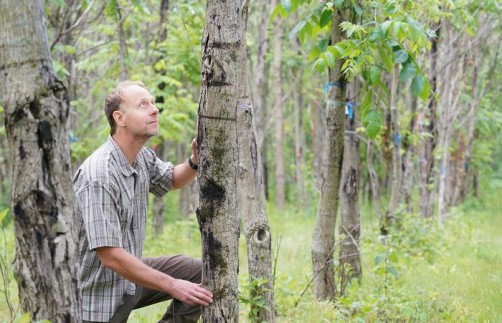Newswise — WEST LAFAYETTE, Ind. –Insights published in the July edition of the journal New Forests suggest that numerous forest tree species facing risks will likely necessitate the combination of biotechnology and traditional tree-breeding methods to ensure their survival.
A team of 19 experts, led by Douglass Jacobs from Purdue University and Kasten Dumroese from the U.S. Forest Service, including scientists, land managers, and regulators, presented their research findings on biotechnological risk assessment and forest tree restoration. Their paper, featured in a special issue on threatened tree species, highlights key outcomes from an international conference held virtually in 2021.
One of their significant conclusions is that societal factors play a crucial role in shaping policies. If genetic engineering becomes the sole option to rescue certain species, its application will depend on public acceptance.
Jacobs, the Fred M. van Eck Professor of Forest Biology, emphasized the broad range of tools encompassed by biotechnology, which can be employed to enhance resistance against pests such as insects or pathogens in our endangered forest trees. However, he noted that many individuals mistakenly associate biotechnology solely with genetic engineering.
According to Douglass Jacobs, traditional tree breeding has been practiced for thousands of years, encompassing the breeding of various species or different varieties within a species. Regulations concerning the cultivation of traditionally bred trees are quite lenient. In contrast, genetic engineering, which falls under the umbrella of biotechnology, is subject to strict regulations. However, it is important to note that biotechnology encompasses more than just genetic engineering.
Scientists utilize genomics, which involves studying the complete genetic material of an organism, to gain insights into disease causes and to identify genes associated with beneficial traits like pest resistance.
The American chestnut tree, despite being the focus of tree-breeding efforts spanning several decades, continues to face uncertainty due to the blight that emerged in the 1900s, resulting in the death of billions of trees. Other species at risk include ash, butternut, and members of the five-needle white pine family, such as the bristlecone pine.
Kasten Dumroese, a research plant physiologist at the Forest Service's Rocky Mountain Research Station in Idaho, expressed a sense of urgency, emphasizing the need for quicker action. The aim is to avoid a prolonged timeline like the century-long struggle with chestnut and instead find expedited solutions.
Dumroese highlighted the alarming trend of species reaching ecological extinction, resulting in the inability to fulfill their historical roles in the ecosystem due to a high mortality rate before reaching maturity. This decline is occurring at an increasingly accelerated pace. He pointed out the rapid loss of ash trees, both from forests and urban landscapes, caused by the introduction of the emerald ash borer insect pest.
The Forest Service's approach to combat white pine blister rust serves as an example, specifically with the western white pine. Since the 1960s, they have effectively employed traditional tree breeding techniques. Although the white pine population remains below its pre-blister-rust levels, significant progress has been made, and the presence of western white pine on the landscape, including new plantings, continues to increase.
Dumroese emphasized the need for a similar accelerated pace in addressing all species at risk. The successful transformation from a significant problem to noticeable improvements in just a couple of decades serves as a blueprint for future endeavors.
Meanwhile, in Indiana, the Hardwood Tree Improvement & Regeneration Center, a collaborative initiative between Purdue University and the Forest Service, has been dedicated to a breeding program focused on pest resistance for many years. The center's efforts have primarily centered around traditional tree breeding and the utilization of genomics.
Jacobs expressed his strong motivation to join Purdue University in 2001, primarily driven by the opportunity to work with chestnut and contribute to its reintroduction into the landscape. The disappearance of species from the environment serves as a personal incentive for him to do everything possible to assist in the conservation of at-risk species.
Over the past decade, Jacobs has witnessed remarkable advancements in innovative biotechnologies that leverage genomics and genetic engineering techniques.
He acknowledged that for certain species, traditional tree breeding may not offer a viable long-term solution to develop disease-resistant trees. In such cases, genetic engineering is likely to be necessary to save the species.
Even for species like the blight-affected American chestnut, which has been the focus of a breeding program for five decades, Dumroese noted that achieving a restoration level comparable to pre-disturbance times within a single lifetime may not be feasible. Nevertheless, he emphasized the importance of initiating conservation efforts, as starting somewhere is crucial in the journey towards recovery.
The attendees of the 2021 conference, representing various backgrounds including academia, the Forest Service, and organizations like the American Chestnut Foundation and the Nature Conservancy, reached a consensus regarding the potential of biotechnology in the reintroduction of threatened forest tree species.
Jacobs highlighted that societal perception and policy are the most challenging aspects to address. He pointed out the historical approach of scientists and government officials attempting to convey information to the public with a one-way flow, essentially stating, "We are scientists, trust us," or "We are the government, trust us." However, he emphasized the necessity for a more interactive dialogue to effectively change public opinion and achieve success in this endeavor.
Support for the conference and related work was provided by the U.S. Department of Agriculture Forest Service and National Institute of Food and Agriculture.

